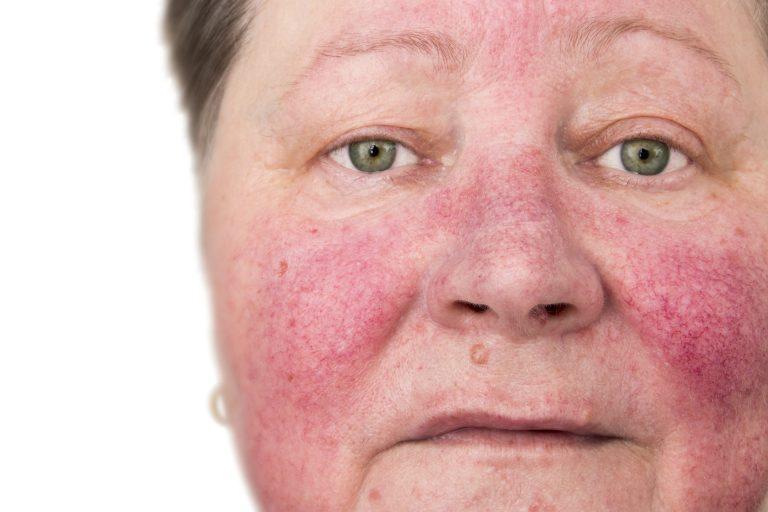

Nasal, chin, forehead and cheeks, especially the face of the middle part of the face, starting with the flushing and burning attacks, then the acne, permanent redness, increased capillaries, edema of the skin is a chronic skin disease that causes a swollen appearance. It is also known as Roza disease, rose disease and laughing.
What are the factors that cause the development of Roza disease?
The cause of Roza disease is not known exactly. Among the accused factors;
1. Genetic predisposition: Family history is 30-40%. However, there is still no clear evidence for the genetic transition.
2. Infectious causes: The most accused infectious agents are the Helicobacter pylori (H pylori) bacteria in the stomach and the demodex mites in the percentage.
3. Environmental factors: Numerous environmental factors such as ultraviolet light and surrounding heat changes play a role in the initiation or exacerbation of rosaceous lesions.
4. Psychogenic factors: Especially intermittent burning and redness attacks can be affected by changes in the patient's mood and psychological stress.
5. Natural immune system: In recent years, the natural defense system in the skin is deficient.
There are four clinical periods;
1st period: Percent recurrent burning and redness attacks,
2nd period: The formation of visible red blood vessels on the nose and cheeks,
3rd period: The redness of the face becomes darker and permanent, small, red swelling on the nose, cheek, forehead and chin, or inflamed acne (unlike white or black spots),
4th term: Burning or permanent sensitivity in the eyes (rosacea in the eye) and / or red, swollen nose (rhinophyma).
What are the clinical features of Roza disease and how is it diagnosed?
It is mostly seen in adult, between 30 and 60 years old, with light-skinned, colored eyes. Although it is more common in women, it is more severe in men.
The diagnosis is usually based on clinical findings. However, a biopsy may be necessary to differentiate it from some diseases. There is no laboratory findings specific to Roza disease.
Is there ocular involvement in Roza disease?
Approximately 1/3 of the patients have eye involvement. In 20% of the patients, only ocular involvement can be seen without skin involvement. Eye involvement is not associated with the presence and severity of skin manifestations. Findings such as blepharitis, conjunctivitis, keratitis, photophobia, watering, burning, chronic ocular edema, diffuse eye pain, blurred vision can be observed in ocular involvement.
What are the factors that increase the clinical manifestations of Roza disease?
1. Foods and drinks (hot and cold drinks with foods soup, tea / coffee, spicy foods, bitter, pickles, chocolate, alcohol ...)
2. Weather conditions (sunlight, hot weather, cold weather, humidity, wind)
3. Psychological stress and excessive exercise
4. Bathroom, cleaning and personal care products (Hot bath and face irritant cleaning materials, cologne, tonic, rose water, wet wipes)
5. Medications (Long-term use of topical corticosteroids)
6. Systemic conditions (premenstrual, pregnancy, menopause, severe cough and constipation)
How is Roza's disease treated?
Although it is difficult for Roza disease to fully heal, it is possible to keep it under control by treatment.
General precautions: The most important thing is to avoid the factors that increase the clinical symptoms.
• Sun protection: One of the most important factors that trigger the disease is the sun. Therefore, you should be careful about sun protection throughout your life. You should use a suitable sunscreen recommended by your dermatologist at intervals of 2-4 hours per day. You should also wear protective hats and goggles from the sun, wear appropriate clothing and avoid exposure to sunlight during sunlight.
• Topical treatment: Cream and gels are usually used in mild cases. The most commonly used metronidazole (cream, gel, lotion), azelaic acid (cream, gel) and sodium sulfacetamide, sulfacetamide + sulfur. Other drugs include tretinoin, benzoyl peroxide, erythromycin, clindamycin, tetracycline, 5% permethrin cream, tacrolimus and pimecrolimus.
• Systemic Treatment: In severe cases, systemic therapy is applied alone or in combination with topical agents. The most frequently preferred systemic agents are systemic antibiotics (minocycline, doxycycline, tetracycline, metronidazole and azithromycin) and isotretinoin, a product of vitamin A.
• Laser treatment: Several laser treatments and intense pulsed light (IPL) systems can be effective in the treatment of redness and capillary vascularization.
• Surgical treatment: Surgical, cryotherapy, electrocautery or dermabrasion can be used especially in severe cases with deformities in the nose and cheeks.
Is there a special diet for Roza?
• Although you do not have a special diet for Roza disease, you should avoid food and drinks that increase the redness. You should also avoid smoking and other tobacco products.